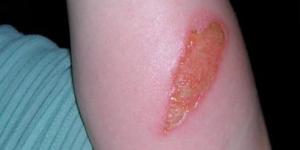How To Know If You Have A Second Degree Burn


Burns are among the most common household injuries, caused by cooking, using certain electric appliances or carrying out electrical repairs. It's important to know how to identify the type of burn you've sustained and seek urgent medical attention. Although first-degree burns are the most common, second-degree burns aren't by any means rare. Here at OneHowTo, we'll give you the facts on how to tell if you have a second-degree burn.
Steps to follow:
Burns can be divided into three different categories: first-degree burns, second-degree burns and third-degree burns. Second-degree burns affect the epidermis, the outer layer of skin, as well as the dermis, the second layer. This type of injury, also known as partial thickness burns, interfere with the skin's functions which, due to the damage sustained, cannot regulate the temperature in that area or protect it from infections.
But how do you know if you have a second-degree burn? These are the main symptoms:
- Redness in the area.
- Severe burning sensation.
- Pain in the burnt area.
- Blistering, the main sign that the dermis has been affected.
- Your skin thikens

All blistering burns are considered to be second-degree. These occur when the epidermis is damaged and is separated from the dermis and liquid accumulates, which finally causes the blister.
Although it is possible to treat a second-degree burn at home, it's important that you visit a doctor if you sustain this type of injury because, due to the skin's inability to heal properly, your risk of contracting an infection is dangerously high.
Seek urgent medical attention if:
- The burn is severe and is about the size of your palm or larger.
- The second-degree burn is a result of a chemical or electrical incident.
- If the person who suffered the burn is in shock or has a fever.
- If you are not completely sure of the extent or degree of the burn.
- Take special care if your burn is in the area of your face, foot, hand or buttocks.
This article is merely informative, oneHOWTO does not have the authority to prescribe any medical treatments or create a diagnosis. We invite you to visit your doctor if you have any type of condition or pain.
If you want to read similar articles to How To Know If You Have A Second Degree Burn, we recommend you visit our Family health category.





